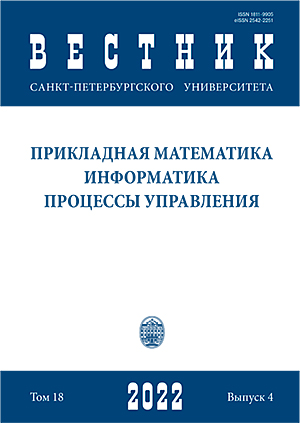Equilibrium in the problem of choosing the meeting time for N persons
DOI:
https://doi.org/10.21638/11701/spbu10.2022.405Abstract
A game-theoretic model of competitive decision on a meet time is considered. There are n players who are negotiating the meeting time. The objective is to find a meet time that satisfies all participants. The players' utilities are represented by linear unimodal functions ui(x), x∈ [0, 1], i=1,2,...,n. The maximum values of the utility functions are located at the points i/(n-1), i=0,...,n-1. Players take turns 1 → 2→ 3 → ...→ (n-1) → n → 1→... . Players can indefinitely insist on a profitable solution for themselves. To prevent this from happening, a discounting factor δ<1 is introduced to limit the duration of negotiations. We will assume that after each negotiation session, the utility functions of all players will decrease proportionally to δ. Thus, if the players have not come to a decision before time t, then at time t their utilities are represented by the functions δt-1ui(x), i = 1, 2,..., n. We will look for a solution in the class of stationary strategies, when it is assumed that the decisions of the players will not change during the negotiation time, i. e. the player i will make the same offer at step i and at subsequent steps n+i, 2n+i, ... . This will allow us to limit ourselves to considering the chain of sentences 1 → 2 → 3 → ... →(n-1) → n→ 1. We will use the method of backward induction. To do this, assume that player n is looking for his best responce, knowing player 1's proposal, then player (n-1) is looking for his best responce, knowing player n's solution, etc. In the end, we find the best responce of the player 1, and it should coincide with his offer at the beginning of the procedure. Thus, the reasoning in the method of backward induction has the form 1 ← 2← 3← ... ←(n-1)← n← 1. The subgame perfect equilibrium in the class of stationary strategies is found in analytical form. It is shown that when δ changes from 1 to 0, the optimal offer of player 1 changes from 1/2 to 1. That is, when the value of δ is close to 1, the players have a lot of time to negotiate, so the offer of player 1 should be fair to everyone. If the discounting factor is close to 0, the utilities of the players decreases rapidly and they must quickly make a decision that is beneficial to player 1.
Keywords:
optimal timing, linear utility functions, sequential bargaining, Rubinstein bargaining model, subgame perfect equilibrium, stationary strategies, backward induction
Downloads
References
Downloads
Published
How to Cite
Issue
Section
License
Articles of "Vestnik of Saint Petersburg University. Applied Mathematics. Computer Science. Control Processes" are open access distributed under the terms of the License Agreement with Saint Petersburg State University, which permits to the authors unrestricted distribution and self-archiving free of charge.





